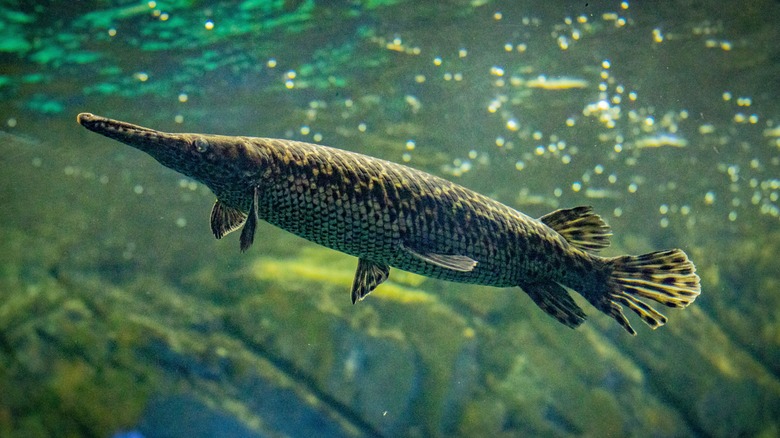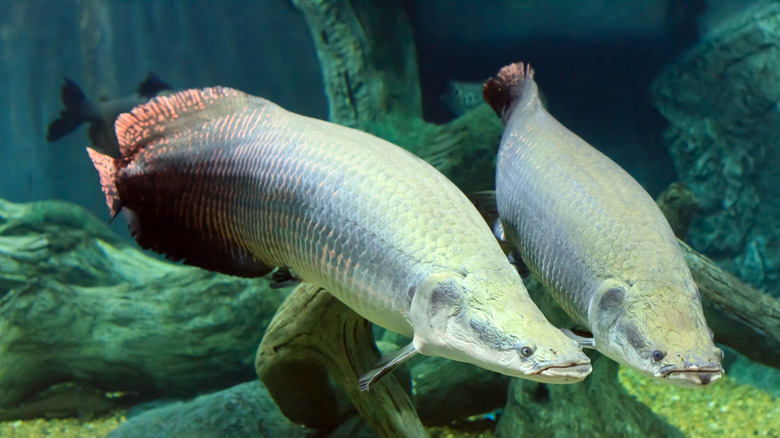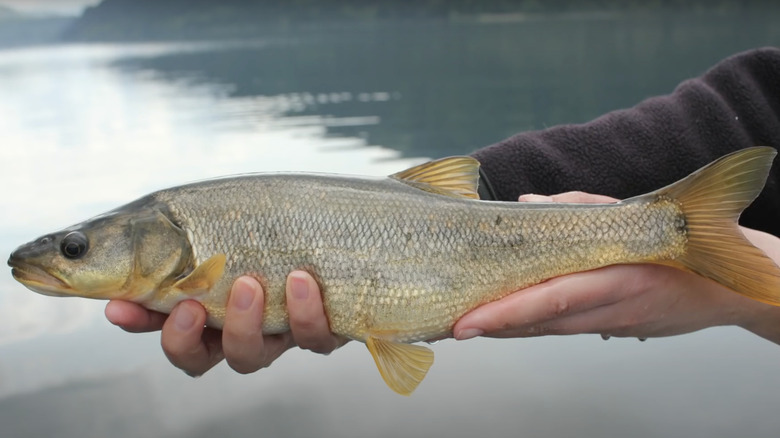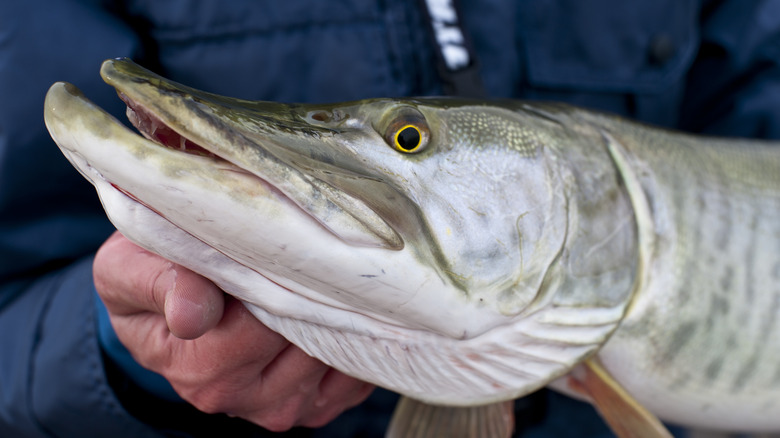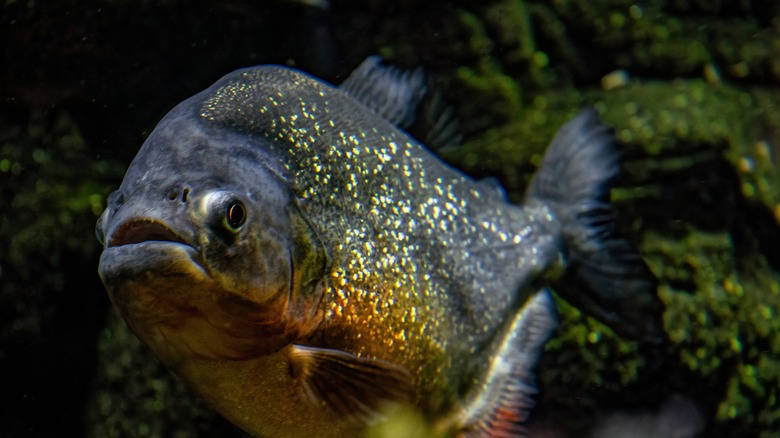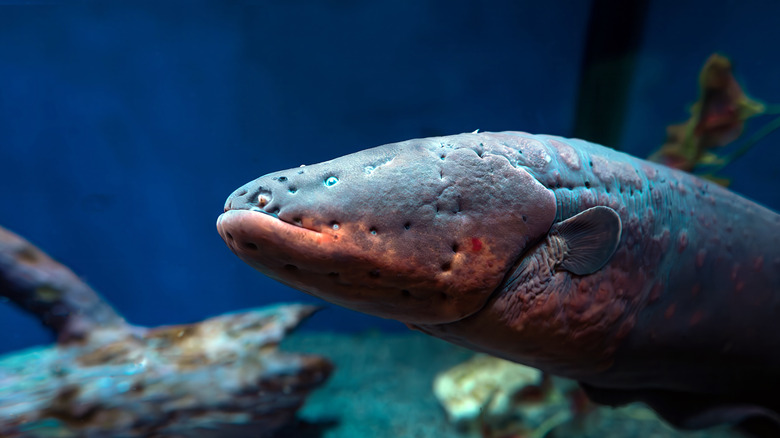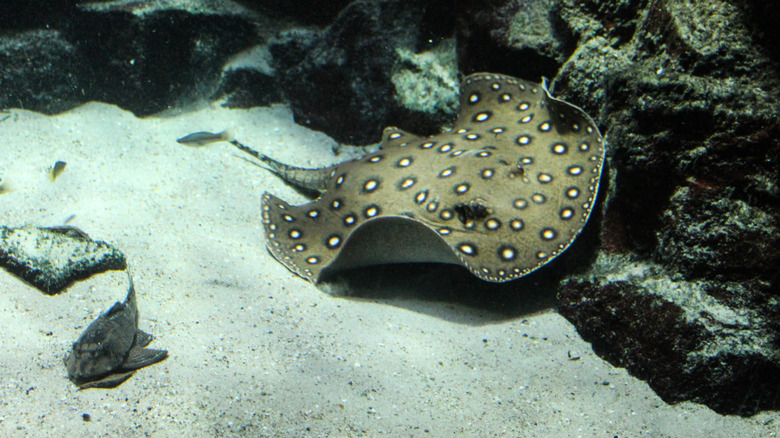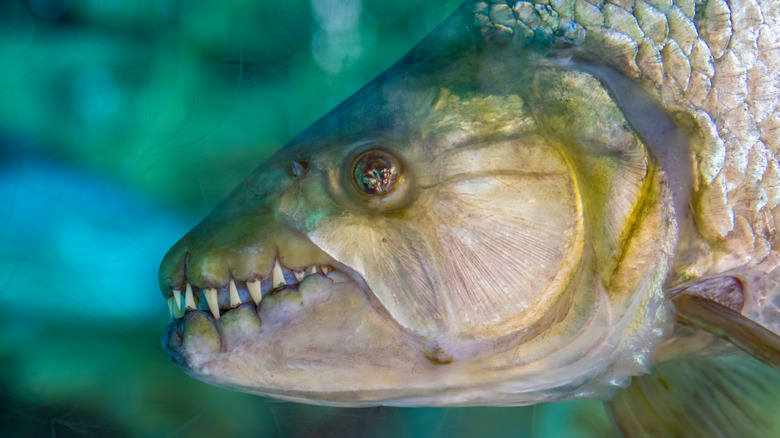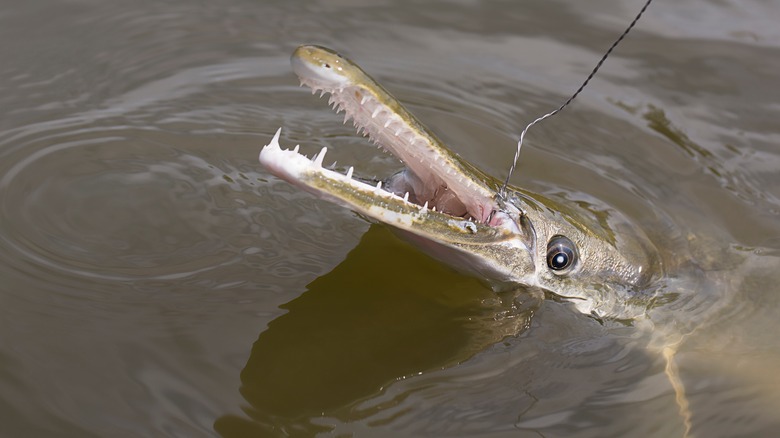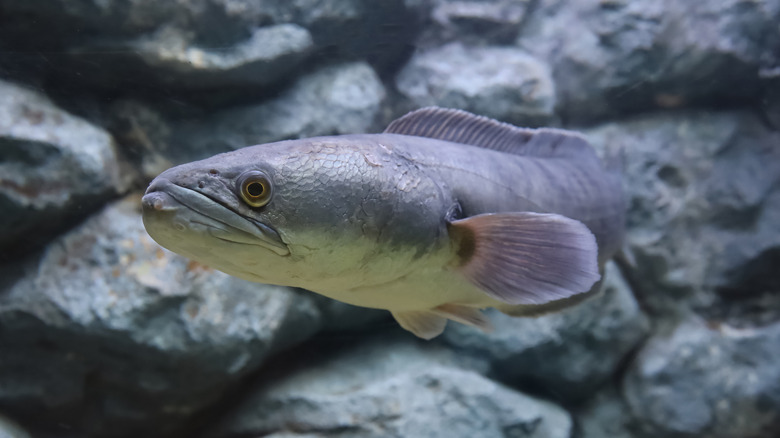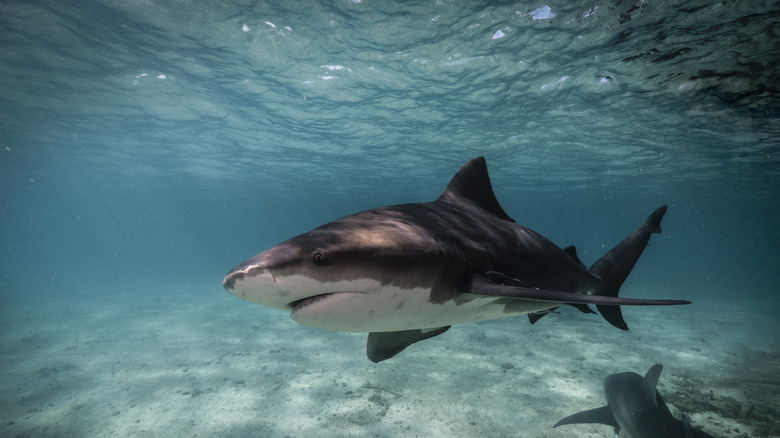10 Types Of Freshwater Fish, Ranked By Danger Level
Freshwater fishing is popular across the world. In most Western countries, freshwater fishing is a recreational activity. The majority of the world, however, still looks to their major fresh waterways as a source of food. While these rivers and lakes offer up a fantastic bounty, there are some fish lurking in the depths that are neither easy to catch, or are altogether friendly.
Though most of us associate dangerous fish with saltwater species such as sharks or jellyfish, there are beasts dwelling beneath the freshwater that put some saltwater species to shame. Some of the largest, most toothsome, and dangerous fish call freshwater their home. Anyone who has ever watched "River Monsters" on Animal Planet will know this to be true.
We've assembled a list of 10 types of freshwater fish, ranked least to most dangerous. We've based this ranking on the fish's aggressive behavior, dangerous physical features, and their capacity to inflict damage. Many of these are not fish you will likely have encountered, owing to the fact that several are located in far flung corners of the world. Nevertheless, an encounter with these fish has the potential to leave you worse for wear.
10. Arapaima are gentle but strong
By far the largest freshwater fish in the Amazon River, the arapaima, known natively as the pirarucu, can measure in at over 10 feet long and can weigh up to 485 lbs. Traditionally hunted for its meat, the arapaima is an omnivorous, gentle giant that tends to shy away from people. However, thanks to its significant size and weight, this fish can pose something of a problem for fishermen.
While it is not considered dangerous in terms of its natural behavior, the arapaima can present problems once it has been hooked. Like any fish, the arapaima will put up a fight, and, thanks to its enormous strength, it is a good fight. They won't hesitate to jump and flail, and can easily tip a boat bound angler overboard. Plus, if anglers aren't careful while taking in the fish, the arapaima will use its full weight to smack itself into the side of an angler's head. This can cause unconsciousness, potentially leading to brain injuries.
These facts have not stopped Amazon fishermen from exploiting the arapaima to near extinction. The good news is that, as of 2022, the local arapaima populations are rising thanks to conservation efforts, according to NPR. Still, this is one fish that should be approached with caution, especially when it is on the end of a hook.
9. The Northern pikeminnow is an angler's nightmare
There are many American anglers who feel that the Northern pikeminnow is an utter nuisance. They don't make for nearly as challenging or attractive a catch as the juvenile salmon and steelhead trout that the pikeminnow enjoys eating so much. Despite being as native fish of the northwestern United States, the pikeminnow is viewed as invasive. The largest of the country's minnows, they can grow upwards of 6 feet long and weigh up to 30 lbs.
Their predatory stature has outfitted the pikeminnow with incredibly sharp teeth that, rather than lining their jaw, line the inside of their throats. This makes it practically impossible for prey to escape. Add to this their natural tendency towards aggression, and you have one moody and territorial fish.
As such, any angler who gets a hook on this fish is going to be in for one heck of a battle. Pikeminnow will devour almost any kind of bait, and once they're hooked they go into a frenzy. If an angler is lucky enough to get one onto the boat, failing to handle this fish properly could lead to several bruises and potential bleeding. These injuries aren't the end of the world, but are certainly not the best thing to happen on a fishing trip.
8. Muskellunge aggression can leave you bloodied
Commonly known as muskies, these enormous fish have a reputation for being absolutely incredible sport fish, with a temper. The aggression with which they attack their prey is not something to be taken lightly. Thanks to their razor sharp teeth, muskies can leave an angler, or swimmer, in bloody ribbons. Colloquially, it is said that they have a fondness for human blood. This myth is perpetuated by the fact that muskies do attack people at random.
Case in point: a 2017 attack reported by the Twin Cities Pioneer Press. A muskie reportedly attacked an 11-year old girl who was swimming in a Minnesota lake. Her upper ankle and foot were covered in deep bites. A similar event occurred in 2020. According to Global News Canada, an Ontario woman was bitten and pulled beneath the surface by a muskie for a few minutes.
While these occurrences are not overly common, the fact that they occur serves as a cautionary tale. Muskies are dangerous. And while the attacks were likely due to the muskie mistaking human limbs for another fish, their strength, aggression, and sharp teeth make them fish that should be handled carefully.
7. Piranhas are misunderstood, but still dangerous
Despite being considered one of the most fearsome fish species in the entire world, piranhas don't actually attack humans all that often. Quite the opposite, in fact. Most species of piranha are vegetarians, and avoid humans altogether. However, this does not mean that there is no cause for caution when it comes to these small fish.
As the only carnivores of the species, red and black bellies species of piranhas are the most associated as dangerous towards humans. According to the Imperial College of London, this is another common misconception, as these piranhas do not attack anything that is larger than they are. This is why, when it comes to human attacks, the majority of injuries sustained amount to no more than a few decent bites.
Still, this does not mean piranha attacks do not happen and cannot be serious. As reported by Smithsonian Magazine, they are able to bite at over 50 times their own body weight, which could easily remove a finger or toe. Per Newsweek, this happened in 2021 when a piranha attack occurred in Argentina that left several swimmers injured and one woman had her toe bitten off. The attack was theorized to have occurred because of the unusually high water temperatures at the time, which may have caused the fish to be overly stressed. So, while attacks like these are rare, they prove that piranhas can occasionally be as dangerous as they are made out to be.
6. Electric eels pack a deadly shock
A member of a species known as knifefish, the electric eel is not known for being outwardly aggressive towards people. Don't be fooled by this demeanor, however. electric eels have the potential to kill. This is because they contain within themselves a potentially lethal electric charge. One of the few animals in existence to be able to harness its inner electricity as a defensive weapon, this asset makes the electric eel one freshwater fish to approach with extreme caution.
According to the National History Museum in the United Kingdom, an electric eel can produce up to 860 volts of electricity. This makes it four times more powerful than a standard wall socket. Seeing as a wall socket can give a nasty shock to anyone foolish enough to stick their fingers into one, imagine how painfully powerful the shock from the electric eel must be.
While it uses its electric charge mainly to navigate, track, and disarm prey, the potential to cause harm to humans is significant. If miffed to the point where it delivers a direct shock, these Amazon River dwellers can easily cause paralysis, heart attacks, and death. This is especially true for anyone with a pre-existing heart condition.
5. Freshwater stingray venom is painful and potent
Yet another large freshwater fish that is not outwardly aggressive towards humans, freshwater stingrays have one tremendous defense mechanism that makes them a force to be reckoned with. Depending on the size of the ray in question, their barbed stingers can sometimes reach upwards of 15 inches long and be used to ward off potential foes. The stingers are filled with a potent venom that can cause pain and necrosis, which is the death of cells around an injury.
According to Phys.org, the venom potency is largely dependent upon sex and age. Young, female stingrays have been found to produce the most potent venom. While adults can still get a good sting in, the severity of the injury is not going to be quite as much as that of a young female stingray. Unfortunately for anyone stung, there is currently no known antidote for stingray venom.
These animals pose a particular problem in the Amazon River. Owing to their natural tendency to hide beneath the sand in shallow water, a person stepping on one is incredibly common, making accidents frequent. This is what makes the danger level so high for these docile-looking fish.
4. Goliath tigerfish haunt African rivers
If there is one fish that roams the freshwaters of Africa that is to be feared above all others, it is the goliath tigerfish. Thought to be a cousin of the piranha, the goliath tigerfish has inspired fear among the locals of the dangerous Congo River where it dwells. Though it lurks on the murky depths, the sight of one of these fish is likely to send you paddling back to shore in a hurry. With massive jaws and teeth capable of ripping anything to shreds, these river monsters are the only known African freshwater fish that has attacked people.
Accounts vary, but as a story from the Animal Planet show "River Monsters," goliath tigerfish will attack out of nowhere, leaping out of the water and sinking their enormous teeth into a person. According to the Daily Mail, these fish are fearless and will routinely attack, and eat, foe that are far bigger than it, such as crocodiles.
Any sporting angler who is fishing on the Congo River will need to be wary of hooking one of these fish. Their brute strength combined with their ferocity make them a formidable challenge. If you do not know what you're doing when you catch one, you could end up bloodied and wounded.
3. Alligator gar are more gator than fish
Yet another river monster that is capable of inflicting more damage than it really wants to, the alligator gar is a staple freshwater predator of the southern United States. Identified by its long bill laced with hundreds of jagged, pointed teeth, the alligator gar, as its name implies, appears to be something of a cross between a gator and a big fish. It has inspired fear for well over 100 years, and has been subjected to eradication efforts for the majority of that period.
Honestly, though, there is a fair chance that an unfamiliar angler might mistake the alligator gar for an actual gator. The gar can grow up to 10 feet long and weigh over 200 pounds, making it a fearsome fighter on the end of a fishing line. However, it does not tend to attack people, instead preferring to lay in wait for carp that swim along the riverbed.
Once again, it is what these creatures are capable of when they are thoroughly harassed that makes them the most dangerous. While the alligator gar has its sharp teeth, they don't tend to use them defensively unless they are significantly set upon. That said, if you aggravate one enough, you could end up with one heck of a bite.
2. Giant snakeheads are invasive and snappy
A species native to freshwater rivers in southeastern Asia, the giant, or northern, snakehead are a large, aggressive fish that have been known to attack humans. Like the goliath tigerfish, most of these attacks are reported by word of mouth. In another episode of "River Monsters," a fisherman supposedly had his leg mauled by a giant snakehead, resulting in some severe injuries. This means that, like other fish on this list, the giant snakehead is not afraid to go after targets larger than itself.
However, the most aggression the giant snakehead displays is when it is defending its nest. They will reach out and snap at anyone or anything that ventures close to them. From an ecological perspective, invasive snakeheads in the United States can be considered a danger to natural habitats. According to the Smithsonian National Zoo, the invasive fish were first discovered in 2002, having been illegally released into the wild.
When it comes to fishing giant snakeheads, anglers would do well to wear gloves as a protective measure. Being bitten by one of these critters is the very last thing you want happening on your fishing trip.
1. Beware bull sharks in shallow water
Lastly, we have perhaps the most dangerous of all freshwater fish, the bull shark. Large, aggressive, and extremely territorial, bull sharks are the only shark known to be able to live for longer periods in freshwater. Not limited by geography, bull sharks can be found from the Mississippi Delta to the rivers of coastal Australia. According to the Smithsonian Environmental Research Center, bull sharks have been reported to travel inland as much as 1,700 miles. So, if you thought you'd never have to worry about a shark while living away from the ocean, think again.
Bull sharks have accounted for nearly all of the shark attacks that have occurred in freshwater. They like to swim in shallow, warm water, a lot of which also happens to be where people swim. And bull sharks have no qualms about attacking people. In 2023, as reported by ABC News, an Australian girl was attacked and killed by a bull shark while swimming in a river. As such, there is reason to be concerned when swimming or fishing in any type of freshwater environment.
There is always a fair amount of danger to be had when swimming or fishing anywhere. Even the most seemingly docile of creatures have ways of defending themselves. So, stay alert, and be careful!
